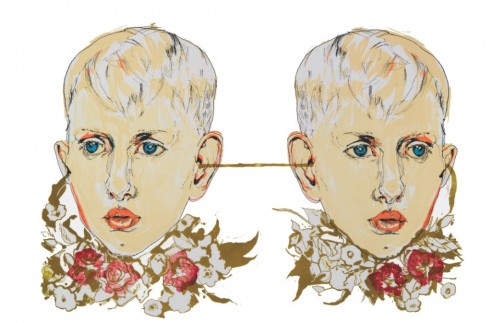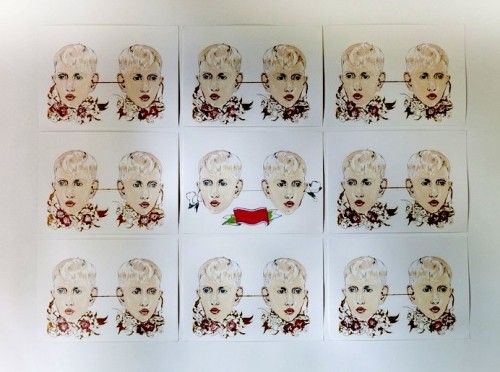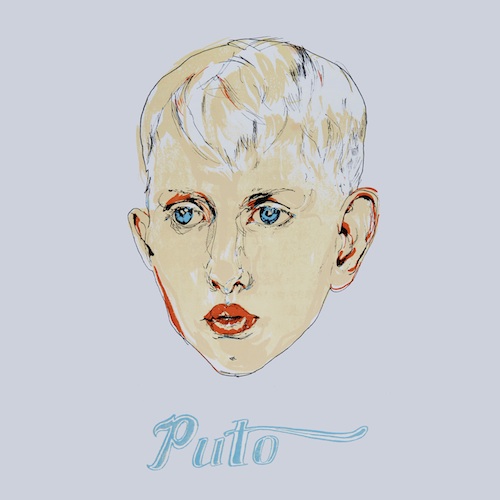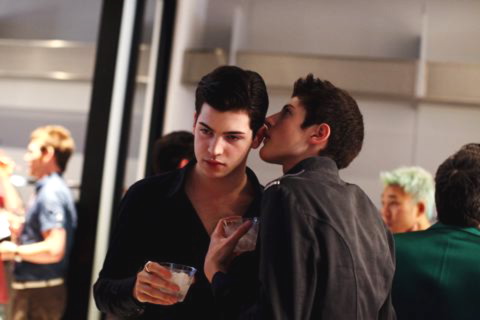
Peregrine Honig. “Analogue Tendril, 2012. Monoprint & lithograph on water-based silkscreen. Photo: EG Schempf. Courtesy the artist.
Peregrine Honig’s experience at the Proyecto Áce Residency in Buenos Aires, Argentina, attuned her senses to an unfamiliar culture as well as her American roots. This sentiment is reflected in the image she honed at the residency: Analogue Tendril, a silkscreen series of two blonde-haired, blue-eyed boys gazing vacantly into a nether space. Honig carried the first phase of this work with her from America to Argentina, multiplying and twinning the imagery before returning home to the United States. Working on this piece at Proyecto added to it cross-cultural meaning, reflecting both Argentina’s political turmoil and loss of wealth post-World War II, and a contemporary American culture rife with wealthy youth.
Initially, Honig was drawn to an image of a boy in a fashion magazine, which she recreated, drawing a younger version of him. “I felt out of my element when I was working with this piece,” says Honig. She made the drawing in America, and quickly began noticing similar looking faces all around her. When the boy drawing arrived in Argentina, however, Honig noticed that he seemed out of place. “The boys were almost extreme–blonde-haired, blue-eyed boys in Argentina where a lot of people were dark-haired with dark eyes.”
Honig was aware that Argentina had been a common destination for Nazis after World War II; a network of Argentinian collaborators helped them escape from Allied forces in Europe. Dinko Sakic, former commander of the Jasenovac concentration camp in Croatia–where unspeakable atrocities were committed against mostly Serbs, Jews and Roma–was discovered in Argentina in 1999, more than 50 years after the war’s end. He had been living there under his real name and making no attempt to conceal his identity.
The boys depicted in Analogue Tendril connect to this history and also a “twin town” in the village of Candido Godo in neighboring Brazil. An Argentinian researcher discovered that the Nazi doctor Josef Mengele, also known as the “Angel of Death,” had lived there post-war, and was responsible for manufacturing the high number of blonde-haired, blue-eyed twins born in this village. Mengele was studying the genetic quirk that produces twins, which he would use to, artificially, increase the Aryan birthrate for Hitler.
To openly discuss such heavy politics in a country where Honig, an American, was a visitor felt, for her, intrusive. Yet it was against silence that the twin boys first began multiplying in South America.
“At the Proyecto Áce Residency, I figured out that these images of boys were supposed to be nine in a row,” says Honig. “To step into a room and see them all together, it totally transformed. It seemed like he was telling me something very important, maybe military or something that happened, maybe a celebration.”

Honig. “Propaganda,” 2012. Monoprint & lithograph on water-based silkscreen. Photo: EG Schempf. Courtesy the artist.
The frilly flowered ruffs that the twin boys wear around their necks suggest an over-the-top indulgence, gaudiness, and an external manifestation of their vulnerable, early adolescent natures.
Another variation of this image presents one boy alone. Beneath him is inscribed “Puto,” a homophobic insult and a slang term for “jerk.” It was a word that Honig heard all around her, and because she didn’t speak Spanish, the word, much like the young boy in her image, stuck out.
Honig’s drawings and paintings often express, among other things, the social anxieties of fictional characters. She says, “I do feel that these boys [I’ve drawn] are being bullied.”

Honig. “Puto,” 2012. Monoprint & lithograph on water-based silkscreen. Photo: EG Schempf. Courtesy the artist.
The thread that runs between the boys’ ears is the same shade of gold seen on pre-Colombian saints in Argentina, and in the decorative arts. At the same time, this slightly dirtied gold tinge calls to mind the disappearance of Argentina’s wealth and subsequent political turmoil following World War II.
“People used to say that you could be ‘as rich as an Argentinian,’ or ‘they’re so rich that they throw butter on the roof,”’ Honig says.
Back in America, Honig’s use of gold ink and twins suggests the symbiotic relationship of characters such as the monied Brant Brothers.
“Harry and Peter II demonstrate the parasitic process in which they’re able to literally ‘pass thoughts’ from ear to mouth, a process that Peter II refers to as ‘baby-birding the old brainbox,’” writes the Brant Watch tumblr blogger.
Honig’s blonde-haired, blue-eyed boys were given another layer of meaning in the United States. They were quickly recontextualized as pop culture saints, or a Peter Pan-cum-Macauley Culkin character, a once adorable, innocuous child celebrity who is unable to grow up.
Honig says of her character, “He does feel very decorated as a boy, but also as an icon.” And yet his eyes remain averted.
Peregrine Honig was the runner-up in the first season of BRAVO’s “Work of Art: The Next Great Artist,” which was followed by her solo exhibition LOSER. In collaboration with Landfall Press, Honig has produced WIDOW Magazine, a limited-edition publication that demonstrates her interest in the intersection of fine art and fashion. Analogue Tendril is featured in her current exhibition LACED, which runs through March 23 at the University of Missouri, Saint Louis.





Pingback: France is for Phonies: Julie Lequin Isolated in Paris | Art21 Blog